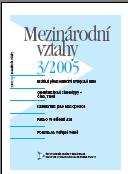Rusko v současné Střední Asii – návrat nebo kontinuita? Případ Tádžikistánu
Russia in contemporary Central Asia: comeback or continuity? The case of Tajikistan.
Author(s): Slavomír HorákSubject(s): Politics / Political Sciences
Published by: Ústav mezinárodních vztahů
Keywords: Tajikistan; Russia; Central Asia; military presence; economic co-operation
Summary/Abstract: The dissolution of the USSR and creation of the New Independent States (NIS) was accompanied by a rapid deterioration in relationships between the component republics. With the disputable exception of the Baltic States, the close dependence of the NIS members on Russia dominated their foreign policies. This reliance was expressed at all levels – political, economic, and particularly social. In this respect, Central Asia became characterictic example. However, Tajikistan is a special case since its dependency on Moscow became a question of survival for the Tajik regime. During the civil war of 1992 to 1997, the Russian armed forces in the country guaranteed at least some stability for president Rahmonov’s government. The conflict prioritised the military and military-political spheres as the determining factors of the countries’ relationship. The formation of a permanent Russian military base in Tajikistan serves to underline this partnership. Yet the ratification of the corresponding agreement was, at least until 2004, one of Dushanbe’s few tools for putting pressure on Russia, particularly in the context of the US’s military presence in the region. Military cooperation is closely linked to economic cooperation. Many companies in Tajikistan are owned by oligarchs close to president Putin. For example, Oleg Deripaska’s aluminium company, RusAl, bought a majority stake in the aluminium factory in Tursunzode, which produces a substantial portion of Tajikistan’s GDP. In addition, Anatoliy Chubays, director of the Russian stateowned United Energy Systems of Russia, has expressed an interest in the construction of massive dams on the Vanch River. The question is whether projects such as this can be realised. Nevertheless, these economic projects do not affect the majority of Tajiks. At the local level, people are primarily preoccupied with social relations. In addition to the ethnic and linguistic links between Russians and Tajiks (on both internal and external levels), a key role is played by labour migration. A huge number of Tajiks leave the country in search of work in Russia. This has implications for the domestic policies of both countries, as well as for their relationship. The above-mentioned levels of Russian-Tajik interaction show that, at least in the case of Tajikistan, we can talk about a consolidation of Russia’s position in Central Asia, but not about a Russian comeback to Central Asia.
Journal: Mezinárodní vztahy
- Issue Year: 40/2005
- Issue No: 3
- Page Range: 93-111
- Page Count: 19
- Language: Czech

